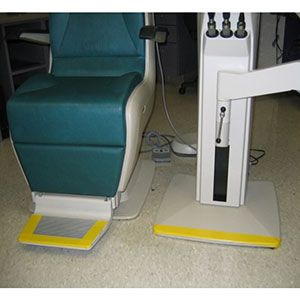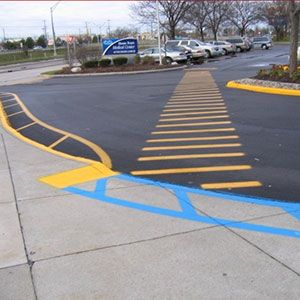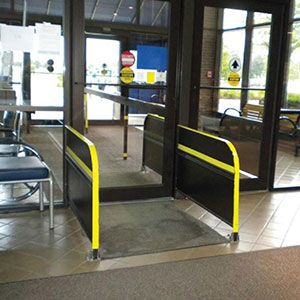How can offices and medical centers do a better job of being more senior-friendly and accommodating for patients with low vision? In addressing this problem, Anne T. Riddering, PhD, suggested modifications that provide a more welcoming environment, reduce tripping and other accidents, and improve ease of movement in the facility. She made practical suggestions for the waiting room, exam rooms, restrooms, and areas outside the building, using recommendations from the SiteWise system.
What is SiteWise? Dr. Riddering’s recommendations come from SiteWise, a multiyear project started at the Henry Ford Health System’s Center for Vision Rehabilitation & Research, funded by the Blue Cross Blue Shield of Michigan Community Foundation. Its goal is to facilitate the activities of seniors, especially those with vision loss, in their communities. Dr. Riddering said, “We looked at how to improve environments for seniors and raise sensitivity among staff and decision-makers.” At her own medical center, a patient fell and broke her hip when she did not see the ramp from the street to the sidewalk because it was not clearly visible.
In the SiteWise study, seniors complained most about difficulties with:
- Steps
- Elevator buttons
- Light
Ways to enhance visibility. In SiteWise surveys, patients reported a variety of difficulties, including elevator buttons and doors that blend in with the background; steps without clearly defined edges and heights; blinding glare from windows; and inadequate lighting, especially in hallways and stairways. These problems may render objects “invisible” to people with low vision, making movement and functioning difficult.
These “invisibility” issues can be remedied with higher contrast in the environment, such as changing out low-contrast chairs in the waiting room, which are hard to manage if they are the same color as floors or walls. In addition, low-definition objects can be made more visible by painting walls a color that contrasts with the furniture. “Even baseboards and railings on stairs painted a contrasting color can make a big difference,” said Dr. Riddering.
In an environmental assessment of your office, she said that “you can tastefully decorate and still have contrast with walls and floors.” Lighting is a major issue, and you want to avoid blinding light, glaring light, and low light in hallways and stairways.
 Contrast tape applied to the feet or pedestals of equipment in exam rooms can help prevent tripping. Educate staff about moving footrests before and after a patient is seated, as they are a frequent hazard.
Contrast tape applied to the feet or pedestals of equipment in exam rooms can help prevent tripping. Educate staff about moving footrests before and after a patient is seated, as they are a frequent hazard.
Don’t forget restrooms. “This is a place I don’t want my patients to reach out and touch,” said Dr. Riddering. Install adequate lighting above sinks and in stalls. Increase visibility behind sinks, commodes, grab bars, trash cans, and emergency pull cords. Even trash cans should stand out so patients don’t bump into them. At least one stall in the restroom should have a higher commode, a grab bar, lever handles, and a pull-cord that reaches the floor in case someone falls to the floor. Make sure you use contrasting colors, advised Dr. Riddering.
 Outside the building. Painted curbs, walkways, railings, and steps provide higher contrast in the environment to help seniors with mobility issues and anyone with low vision. Most important for seniors and those with low vision is that they can see changes in surfaces. Parking lots with painted walkways and crosswalks do get used by patients and slow down traffic to make everyone safer. There are fewer falls, and patients appreciate the safe and welcoming environment.
Outside the building. Painted curbs, walkways, railings, and steps provide higher contrast in the environment to help seniors with mobility issues and anyone with low vision. Most important for seniors and those with low vision is that they can see changes in surfaces. Parking lots with painted walkways and crosswalks do get used by patients and slow down traffic to make everyone safer. There are fewer falls, and patients appreciate the safe and welcoming environment.
Entryways with clear contrast make for easier movement on arrival and departure and provide a more pleasant experience for patients. “We want patients to have good memories of our facilities,” said Dr. Riddering.
 Other recommendations include using large appointment cards, signs, and lettering, clearing any floor obstacles from hallways, and removing or taping off objects protruding from walls. For example, a wall-mounted water fountain can be particularly problematic, as canes go right under them, and the patient can bump into the fountain, warned Dr. Riddering.
Other recommendations include using large appointment cards, signs, and lettering, clearing any floor obstacles from hallways, and removing or taping off objects protruding from walls. For example, a wall-mounted water fountain can be particularly problematic, as canes go right under them, and the patient can bump into the fountain, warned Dr. Riddering.
“Educating staff to be knowledgeable about environmental issues and adaptations and to cover risks will result in increased safety for everyone, especially seniors,” said Dr. Riddering.
Takeaway tips for patient safety and accessibility:
- Maximize light
- Minimize glare
- Avoid shadows
- Make entryways and doors and doorways obvious
- Maximize contrast in color and texture
- Use large signage and large lettering
- Remove protruding objects if possible
- For necessary protruding objects, add contrast
- Keep walkways clear
- Ensure that objects don’t blend into the background
For more information about SiteWise recommendations, contact Dr. Riddering at aridder1@hshf.org. —Kathleen Erickson